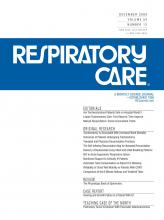Abstract
BACKGROUND: Measurements of chest wall circumference are commonly used by physical therapists in clinical practice in order to determine chest wall mobility. However, the variability in the method for measuring this has not been reported previously among patients with chronic obstructive pulmonary disease.
OBJECTIVE: To analyze the reliability and accuracy of chest wall mobility measurements and to investigate the association between chest wall mobility and inspiratory capacity.
METHODS: Twenty-six patients with chronic obstructive pulmonary disease (forced expiratory volume in the first second = 45 ± 14% of predicted) were evaluated over 2 visits. Spirometry was performed during the first visit, to characterize the sample. At each visit, 2 independent observers made chest wall mobility measurements twice, at the levels of the axillary, xiphisternal, and abdominal regions (total of 4 measurements), using a measuring tape.
RESULTS: Despite high variability at all levels, the main results were that (1) two measurements made on the same day by the same observer showed good reliability (intraclass correlation coefficient 0.84-0.95); (2) two independent observers making the measurements on the same day showed fair-good reliability (intraclass correlation coefficient 0.69-0.89); (3) the same observer making the measurements at different visits, at least 2 days apart, showed good reliability (intraclass correlation coefficient 0.64-0.84); (4) inspiratory capacity was not associated with axillary and xiphisternal mobility, but it was closely related to measurements taken at the abdominal level.
CONCLUSIONS: In summary, despite high reliability of intra-observer and inter-observer measurements, both within and between visits, high variability was observed in all chest wall mobility measurements. Although there was an association between inspiratory capacity and measurements made at the abdominal level, chest wall mobility did not correlate with pulmonary function.
Footnotes
- Correspondence: Carla Malaguti PT PhD, Rehabilitation Sciences Master's Program, University Nove de Julho, Av Francisco Matarazzo 612, Agua Branca, São Paulo 05001-100 Brazil. E-mail: carlamalaguti{at}uninove.br.
This research was partly supported by the Brazilian National Council for Scientific and Technological Development (Conselho Nacional de Desenvolvimento Científico e Tecnológico).
The authors have disclosed no conflicts of interest.
- Copyright © 2009 by Daedalus Enterprises Inc.







